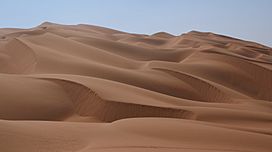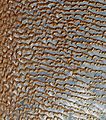Rub' al Khali facts for kids
Quick facts for kids Rub' al Khali |
|
|---|---|
| ٱلرُّبْع ٱلْخَالِي | |

Sand dunes to the east of Liwa Oasis in the Emirate of Abu Dhabi, near the UAE's border with Saudi Arabia
|
|

Location of the empty quarter in the Arabian Peninsula.
|
|
| Length | 1,000 km (620 mi) |
| Width | 500 km (310 mi) |
| Area | 650,000 km2 (250,000 sq mi) |
| Geography | |
| Countries | |
The Rub' al Khali, also known as the Empty Quarter, is a huge desert in Saudi Arabia. It is one of the biggest sand deserts in the whole world. This desert covers about 650,000 square kilometres. That's larger than Holland, Belgium, and France put together! Some of its sand dunes are super tall, reaching over 250 metres high.
Contents
What is the Empty Quarter?
The Rub' al Khali is a vast area of sand. It is part of the larger Arabian Desert. This desert is known for its extreme conditions. It has very little rain and very high temperatures.
Where is it located?
The Empty Quarter is mostly in Saudi Arabia. But it also stretches into parts of Oman, the United Arab Emirates, and Yemen. It's a huge sandy area in the southern part of the Arabian Peninsula.
Why is it called the Empty Quarter?
It gets its name because it's mostly empty of people. It's a very harsh place to live. For a long time, it was one of the least explored places on Earth. This is due to its size and difficult environment.
Life in the Desert
Even though it's a tough place, some life exists here. The desert has adapted to the extreme heat and dryness.
Plants and Animals
You might not expect much life, but some plants and animals call it home.
- Small rodents and reptiles can be found.
- Some types of spiders and scorpions live there too.
- A few types of grasses and shrubs grow in certain spots. These plants are very tough and can survive with little water.
Climate and Weather
The Empty Quarter is one of the hottest and driest places on Earth.
- Temperatures can reach over 50°C (122°F) in summer.
- Rainfall is very rare, sometimes less than 30 millimetres (1.2 inches) a year.
- Strong winds can create huge sandstorms. These storms can change the shape of the dunes.
Exploring the Rub' al Khali
For centuries, this desert was a mystery. Few people dared to cross it.
Early Explorers
Local Bedouin tribes knew parts of the desert. But they rarely went deep into its heart. The first Western explorers only managed to cross it in the 20th century.
- In 1931, Bertram Thomas was the first Westerner to cross a large part of it.
- Later, in the 1940s, Wilfred Thesiger made several famous journeys. He wrote books about his adventures. He traveled with local guides and camels.
Modern Exploration
Today, modern technology helps us learn more about the desert.
- Satellites can map the dunes and see changes over time.
- Scientists study the desert's geology and climate history.
- Oil companies have explored parts of it for petroleum and natural gas.
Images for kids
-
Astronaut photograph highlighting a part of Ar-Rub' al-Khali near its south-eastern margin, in the Wusta Governorate of Oman
See also
In Spanish: Desierto de Rub al-Jali para niños




